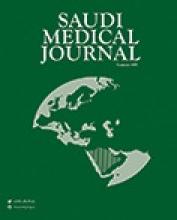Abstract
OBJECTIVE: To evaluate the relationship between head posture and anteroposterior skeletal patterns in female adult patients.
METHODS: The study included 75 lateral cephalograms of orthodontic patients in the age range of 18-25 years. The study was conducted from May 2012 to January 2013 at the College of Dentistry, King Saud University, Riyadh, Kingdom of Saudi Arabia. The lateral cephalograms were divided into 3 groups based on the anterior-posterior skeletal relationship angle: skeletal class I, II, and III. Twenty-three craniofacial morphological variables were identified and used. The Kruskal-Wallis and Mann-Whitney U tests were used to determine significant differences among the 3 skeletal classifications. The Spearman correlation coefficient between the cervical lordosis angle and the cervical curvature with the postural variables were estimated. Significance was set at the p<0.05 level.
RESULTS: Significant differences were observed in the mandibular plane inclination between class I and II (p<0.04), and between class II and III (p<0.028). Cervical curvature showed a significance difference between class I and II, and between class I and III (p<0.000). In Class I, II, and III the cervical lordosis angle positively correlated with the upper and middle parts of the cervical column. Cervical curvature correlated negatively with the upper part of the cervical column in class I, while positively correlated in class II and III. The class III group showed a more forward head posture, while the class II group showed a greater head extension.
CONCLUSION: No clear relationship was found between head posture and the different skeletal patterns, and it does not seem to play a significant role in the development of different anteroposterior skeletal relationships.
- Copyright: © Saudi Medical Journal
This is an open-access article distributed under the terms of the Creative Commons Attribution-Noncommercial-Share Alike 3.0 Unported, which permits unrestricted use, distribution, and reproduction in any medium, provided the original work is properly cited.






